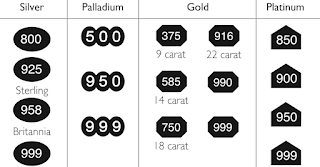How To Buy Jewellery and Not Get Scammed! - A Guide to Hallmarks
The History of Hallmarks
The concept of hallmarking itself dates to nearly 400 AD and was discovered on silver objects from the Byzantine period.The purpose of a hallmark is to certify the metal purity of the item, so you know what quality of gold, silver, or platinum you are buying. I have written another article specifically on the purity of gold if you'd like to read here.
The locations where where hallmarking is done are called Assay Offices. Referring to the act of testing precious metals for purity, called “assaying”.
The earliest attempt at regulating the standard of gold and silverwares was made in 1238, when Henry III passed an order commanding the mayor and aldermen of the City of London to choose at least six secret goldsmiths to supervise the craft.
The ‘Guardians of the craft’ were to go from ‘shop to shop’ to assay work and apply the leopard’s head mark. Silver had to be of sterling standard (92.5% pure silver) and gold had to be of the ‘touch of Paris’ (19.2 carats). These standards were also applied outside of London.
‘No goldsmith… shall from henceforth make or cause to be made any manner of vessel, jewel or any other thing of gold or silver except it be of the true alloy and that no manner of vessel of silver depart out of the hands of the workers, until further, that it be marked with the leopard’s head’.
- Statute of Edward I in 1300
UK Hallmark only have a few compulsory parts these days:
- the sponsor or maker's mark
- the assay office mark
- the standard of fineness (aka. the ratio of precious metal to additional alloys)
Hallmark identification should answer four important questions - where; what; when; who. And so, the four components of a hallmark are: the sponsor or maker's mark, the standard mark, the assay office mark, and the date letter for the year. This ensures that you guys as consumers are protected from forgeries.
But the main thing you as a customer need to know when checking jewellery you're buying from sources you don't fully trust is the metal, which is the main indicator of a fair price.
While some metals such as yellow gold are distinguishable, you still need to know the purity in the gold. As between 9ct and 18ct gold of any tone, the price of a piece of jewellery can nearly double.
The main hallmarks you'll need to know for gold in the UK are 375 (9ct), 585 (14ct) and 750 (18ct).
The main other use of hallmarks for customers is telling the difference between visually similar metals; mainly silver, platinum and white gold.
Stirling silver will show 925, platinum will show 950 and white gold will hold any of the hallmarks previously mentioned for gold!
It is important to note that some precious stones will be indicated too, such as 'DIA' on the inside of a diamond ring. If you would like to find out more about how diamonds are graded click here!
For example, this ring here has a diamond stone set in sterling silver.








Comments
Post a Comment